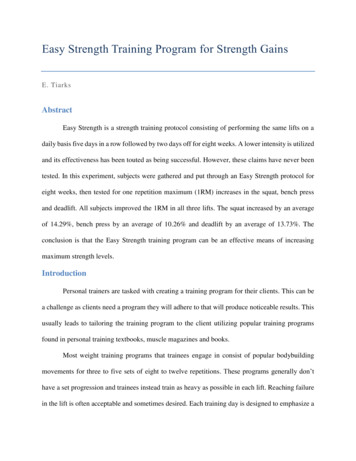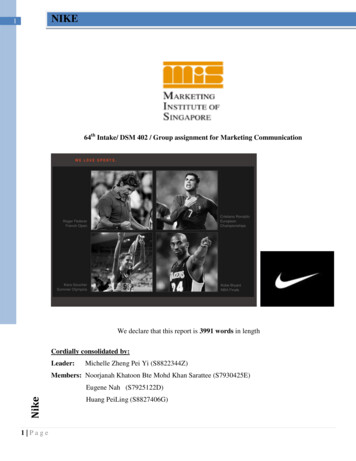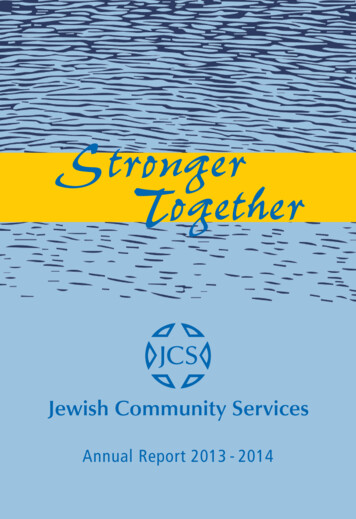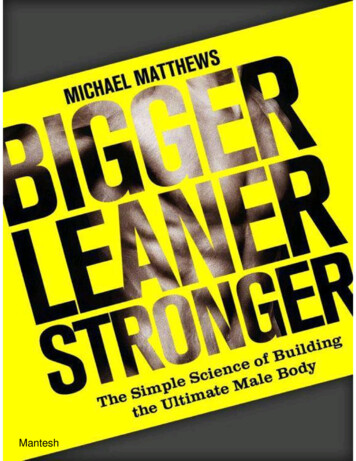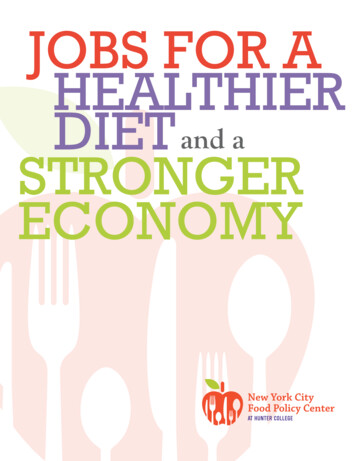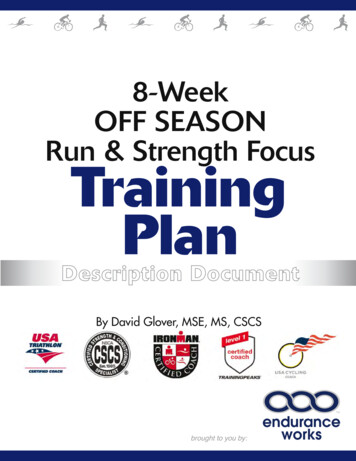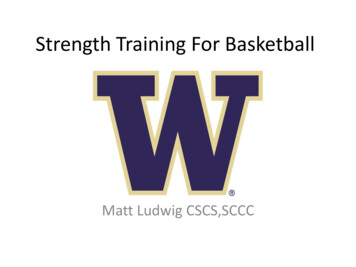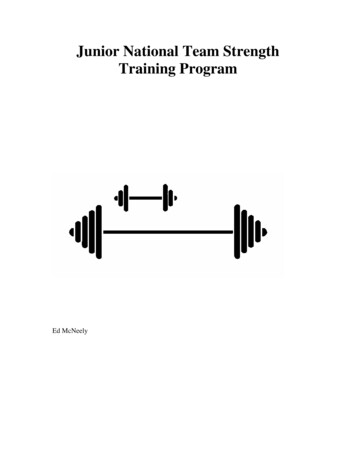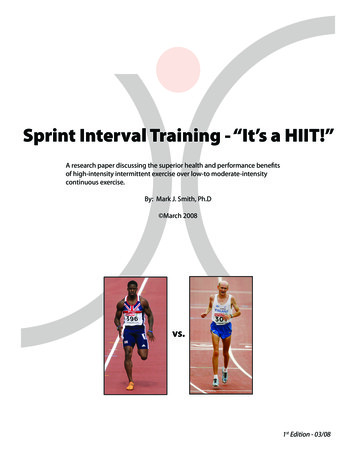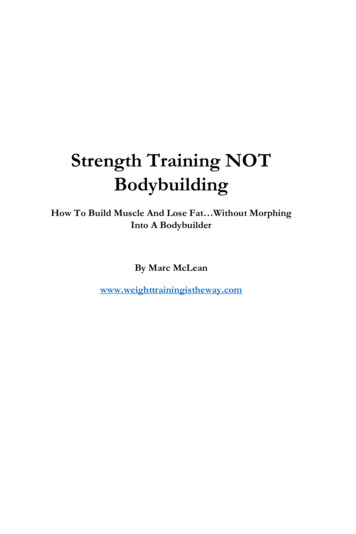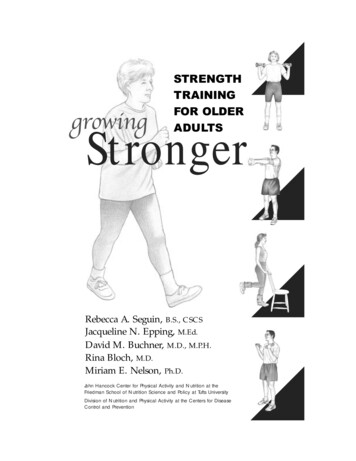
Transcription
growingSTRENGTHTRAININGFOR OLDERADULTSStrongerRebecca A. Seguin, B.S., CSCSJacqueline N. Epping, M.Ed.David M. Buchner, M.D., M.P.H.Rina Bloch, M.D.Miriam E. Nelson, Ph.D.John Hancock Center for Physical Activity and Nutrition at theFriedman School of Nutrition Science and Policy at Tufts UniversityDivision of Nutrition and Physical Activity at the Centers for DiseaseControl and Prevention
Each year, we learn more about thetremendous health benefits ofstaying physically active and beingproperly nourished throughout ourlives. The work of scientists, healthprofessionals, and older adult volunteershas greatly increased our knowledgeabout the aging process and how wecan maintain strength, dignity, andindependence as we age.Essential to staying strong and vitalduring older adulthood is participation in regular strengthening exercises,which help to prevent osteoporosis and frailty by stimulating thegrowth of muscle and bone. Feeling physically strong also promotesmental and emotional health. Strength training exercises are easy tolearn, and have been proven safe and effective through years ofthorough research.Experts at the Centers for Disease Control and Prevention and TuftsUniversity, with the help of older adults, have created this book,Growing Stronger: Strength Training for Older Adults to help youbecome stronger and maintain your health and independence. Iencourage you to read it carefully and begin using this strength trainingprogram as soon as possible. It can make a profound difference inyour physical, mental, and emotional health.Let us aim, as a nation, to Grow Stronger together. To your health—David Satcher, M.D., Ph.D.Director, National Center for Primary CareMorehouse School of MedicineUnited States Surgeon General, 1998-2002
STRENGTHTRAININGFOR OLDERADULTSgrowingStrongerRebecca A. Seguin, B.S., CSCSJacqueline N. Epping, M.Ed.David Buchner, M.D., M.P.H.Rina Bloch, M.D.Miriam E. Nelson, Ph.D.122111From the John Hancock Center for PhysicalActivity and Nutrition at the Friedman School ofNutrition Science and Policy at Tufts University,Boston, Massachusetts.2From the Division of Nutrition and PhysicalActivity at the Centers for Disease Control andPrevention, Atlanta, Georgia.U.S. DEPARTMENT OF HEALTH AND HUMAN SERVICESCenters for Disease Control and Prevention
Illustrations by Wendy Wray/Morgan Gaynin Inc., NYC.The PAR-Q test on pages 14 and 15 reprinted fromthe 1994 revised version of the Physical Activity ReadinessQuestionnaire (PAR-Q and YOU). The PAR-Q and YOU is acopyrighted, pre-exercise screen owned by the CanadianSociety for Exercise Physiology.This material is based upon work supported by theU.S. Department of Agriculture under agreement number58-1950-9-001 and the Association of Teachers of PreventiveMedicine/Centers for Disease Control and Prevention/Agency forToxic Substances and Disease Registry cooperative agreementnumber TS 359-15/16. Any opinions, findings, conclusion, orrecommendations expressed in this publication are those ofthe author(s) and do not necessarily reflect the views of theseorganizations.This book was produced for free distribution by anymeans, electronic or mechanical, including photocopying,recording, or by any information storage and retrieval system, without requiring permission. However, please creditthe authors and Tufts University and do not change any ofthe content.Copyright 2002 by Tufts University.Printed in the United States of America.
ContentsACKNOWLEDGMENTSiPREFACEAn Exercise Program for YouCHAPTER 1The Power of Strength Training1CHAPTER 2Making Change4CHAPTER 3Getting Motivated7CHAPTER 4Starting Your Journey: 6 Simple Steps13CHAPTER 5Getting Stronger: A 3-Part Program32CHAPTER 6The Courage to Progress70CHAPTER 7Staying on Track: Your 12-Week Workbook74APPENDIXResources for Staying Strongiii103GLOSSARY107INDEX109
An Important CautionThe Growing Stronger exercise program is based onextensive scientific research. The book contains detailedinstructions and safety cautions, and you are urged toread them carefully. If you are under a physician’s carefor a medical condition, discuss this program with himor her before you start. Remember that regular medicalcheckups are essential for your health and well-being.While this book can serve as your guide to growingstronger and becoming more physically active, it cannotreplace the advice of a health care professional whoknows you personally.
AcknowledgmentsThis book would not have been possible without the timeand assistance of our Peer Advisory Board members, SisterMary Patrice, Al, Dorothy, and Helen. These individualsunselfishly donated their time; some provided their expertiseand others shared their experiences of living with arthritis aswell as starting—and continuing—a strength trainingprogram. Several of the Peer Advisory Board members werevolunteers in our research center for arthritis studies, whichare the foundation for the Growing Stronger program. Weare so grateful for their help with this project.Before completing this book, we worked with anotherset of volunteers whose insight was invaluable to the successof this book. These individuals had no previous experiencewith strength training, and they volunteered to try theGrowing Stronger program on their own and provide feedback on numerous aspects of the book and exercises. Wewish to extend our sincere gratitude to these volunteers andto the countless others like them who have made enormous
iiGrowing Stronger: Strength Training for Older Adultscontributions to keep scientific research moving forward andwithout whom our work would not be possible.Several of our colleagues at Tufts and elsewhere contributed to the success of this project. Many thanks to Drs.Irwin Rosenberg, Ronenn Roubenoff, Kristin Baker, and BessMarcus for their encouragement as well as their personalcontribution to the body of research that helped form thebasis for the Growing Stronger program. Jennifer Layne,M.S., CSCS, donated her time to review the exercise program.Her expertise and experience was invaluable. Finally, to all ofthe members of the Nutrition, Exercise Physiology andSarcopenia Laboratory as well as our other colleagues atTufts University and the Centers for Disease Control andPrevention, we are grateful for your feedback about thisbook and for your continued support.We had the benefit of collaborating with several talented individuals for different aspects of this book. We wishto acknowledge Jennifer Ackerman for her editorial geniusand thoughtful contribution to reshaping certain sections ofthe book. Thank you to Wendy Wray for the wonderful illustrations and to Ilana Rosenberg for her creative energy anddiligent work on the design of this book.
iiiprefaceAn ExerciseProgram for YouIn choosing to read this book, you have taken the first stepon a journey toward greater strength and vitality. GrowingStronger was written for you—the older adult who wants togrow stronger, healthier, more active, and more independent.You may be inactive or only mildly active at the moment.You may know that regular exercise is important for yourhealth and well-being and want to get started on a programof physical activity. But you may feel that you don’t have thenecessary information. Perhaps you are concerned thatbecause of your age or health problems physical activity maynot be safe for you. Or perhaps you have had trouble findingor staying with a suitable program.This book gives you a safe, simple, and highly effectiveexercise program based on the principles of strength training.Studies at laboratories around the world have shown thatstrength training benefits women and men of all ages and alllevels of fitness. According to Physical Activity and Health:A Report of the Surgeon General (1996), experts agree thataerobic activities should be supplemented with strength-
An Exercise Program for Youivdeveloping exercises at least twice per week.These activities will help you:build strengthmaintain bone densityimprove balance, coordination, and mobilityreduce your risk of fallingmaintain independence in performing activitiesof daily life.Strength training requires little time and minimalequipment. And it’s safe, even for people with health problems. The strength training “prescription” featured here—the motivational tips, safety precautions, and specificexercises—was developed at the Nutrition, ExercisePhysiology and Sarcopenia Laboratory at Tufts University.Whatever your age, medical condition, or current level ofactivity, you are likely a perfect candidate for this gentle butpowerful program.This book gives you all the tools you need to succeedin this exciting program. It introduces you to the manyadvantages of strength training—boosts in strength, energy,and vitality and the role it plays in helping to prevent and
An Exercise Program for Youvtreat such chronic diseases as arthritis and osteoporosis. Ithelps you decide whether these exercises are safe for you orwhether you need to consult with your doctor first. It offersa program tailored to your needs, with step-by-step instructions on getting started, staying on track, and growingstronger and healthier as you age. At the end of the book isa 12-week workbook in which you can record and gaugeyour progress and celebrate your success.The goal of this program is to help you make strengthtraining a lifelong habit. By doing so, you will be on yourway to a strong, independent, and vibrant life!
chapter1The Powerof Strength TrainingFor many older adults, growing older seems to involve aninevitable loss of strength, energy, and vigor. But it need notbe so. The frailty and decreased energy we associate withaging, such as difficulty walking for distances, climbingstairs, or carrying groceries, are largely due to muscle loss.This muscle loss results mainly from inactivity. The old saying is true when it comes to muscle: “Use it or lose it.”One of the best ways to keep muscles healthy andstrong is through exercises called strength training—sometimes known as weight lifting or resistance training. Studiesat Tufts University have shown that strength training is oneof the best ways to fight the weakness and frailty that cancome with age. Done regularly, strength training builds boneand muscle and helps to preserve strength, independence,and energy. These exercises are safe and effective for womenand men of all ages, including those who are not in perfecthealth. In fact, people with health concerns—such asarthritis or heart disease—often benefit the most from an
The Power of Strength Training2exercise program that includes lifting weights a few timeseach week.Strength training can also reduce the signs andsymptoms of many diseases and chronic conditions in thefollowing ways:Arthritis—Reduces pain and stiffness, and increasesstrength and flexibility.Diabetes—Improves glycemic control.Osteoporosis—Builds bone density and reduces riskfor falls.Heart disease—Reduces cardiovascular risk byimproving lipid profile and overall fitness.Obesity—Increases metabolism, which helps burn morecalories and helps with long-term weight control.Back pain—Strengthens back and abdominal musclesto reduce stress on the spine.Strength training, when done with regular aerobicexercise, can also have a major effect on a person’s mentaland emotional health. Studies have shown that people whoexercise regularly sleep better; they sleep more deeply andlonger and awaken less often. Strength training exercises can
The Power of Strength Training3also reduce depression and boost self-confidence and selfesteem, and improve your sense of well-being.The exercises that make up the Growing Strongerstrength training program have been widely tested on healthyindividuals and people with chronic but stable medicalconcerns. No matter how old you are, you do not have to getweaker with age. Strength training can help you stay vital,strong, and independent throughout your life. Start theGrowing Stronger program and make it a regular part ofyour life so you can begin enjoying the many physical andemotional benefits of strength training today.
chapter2Making ChangeIntroducing any major change into our daily lives canbe very challenging. Starting an exercise program is likesetting off on a journey; it requires a step-by-step approach.When making any major lifestyle changes, most peoplego through 5 stages, as defined by the transtheoreticalmodel: pre-contemplation, contemplation, preparation,action, and maintenance.CONTEMPLATION — GETTING MOTIVATEDBy reading this book, you have already moved beyond precontemplation, which is the stage in which you’re not yetthinking about strength training. In contemplation, you areintrigued by what you have heard about strength training.Reading about the health benefits of these exercises or hearing about them from a friend or doctor has stimulated yourinterest in starting the program yourself. At this stage, youwork on getting motivated, thinking about your goals, andasking yourself what you want to get out of the program.This is also the time to address possible obstacles and findways to overcome them.
Making Change5PREPARATION—STARTING YOUR JOURNEYYou are ready to take action once you have thought aboutyour motivations and goals for strength training. At thisstage, you take steps to prepare for a new exercise program.You set aside the physical space needed to do the exercisesand buy any equipment you may need. You look at yourschedule to see where strength training might fit in and setspecific exercise days and times.ACTION—ADOPTING THE PROGRAMAt this exciting stage, you are learning the exercises anddoing them 2 or 3 times per week. You are beginning to seethe results of your work. You notice physical changes andfind that your clothes fit a little better and that you feelstronger, more energetic, and happier. Technically, the actionstage continues as long as you are engaged in the program.But after about 6 months of doing the exe
Contents ACKNOWLEDGMENTS i PREFACE An Exercise Program for You iii CHAPTER 1 The Power of Strength Training 1 CHAPTER 2 Making Change 4 CHAPTER 3 Getting Motivated 7 CHAPTER 4 Starting Your Journey: 6 Simple Steps 13 CHAPTER 5 Getting Stronger: A 3-Part Program 32 CHAPTER 6 The Courage to Progress 70 CHAPTER 7 Staying on Track: Your 12-Week Workbook 74
